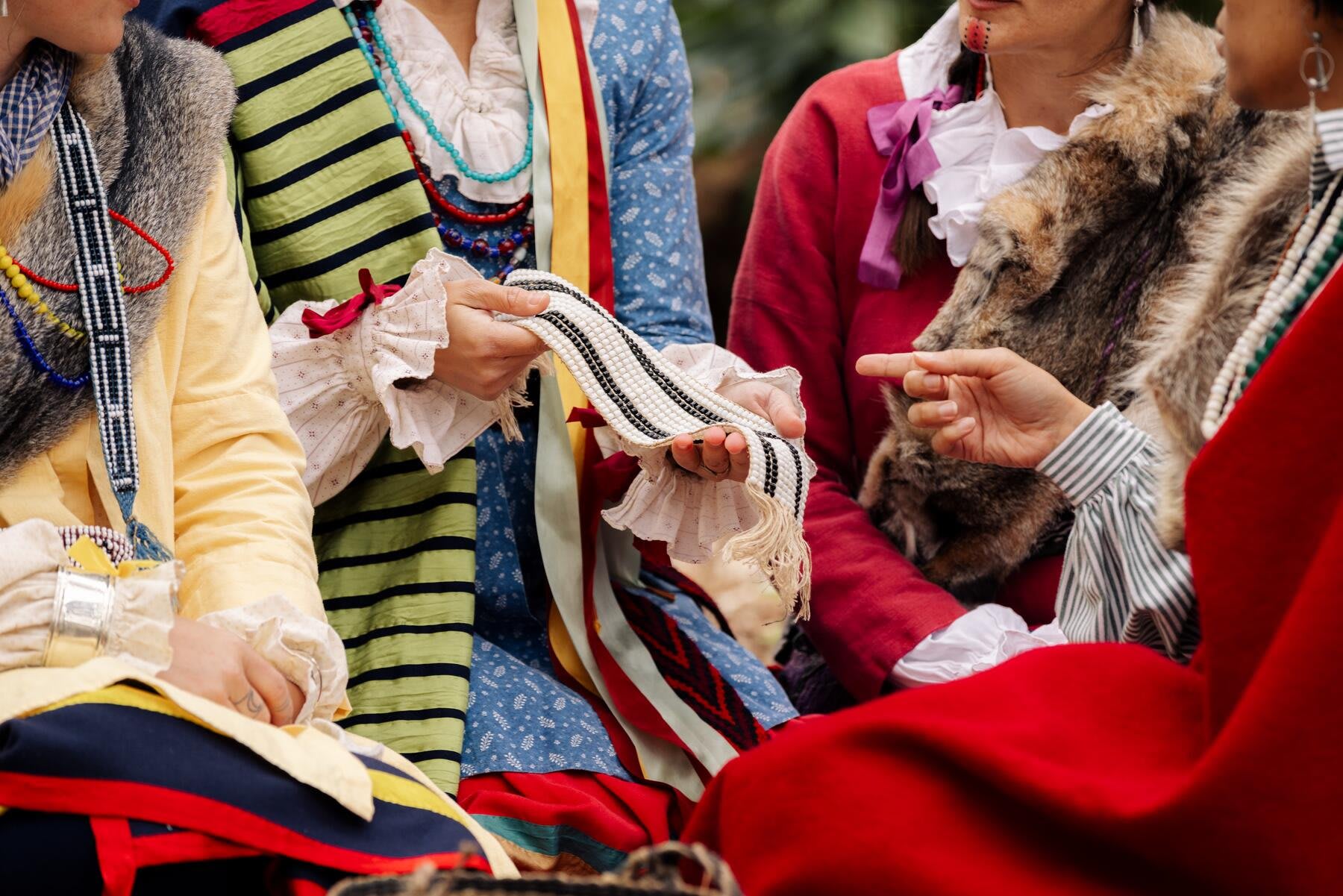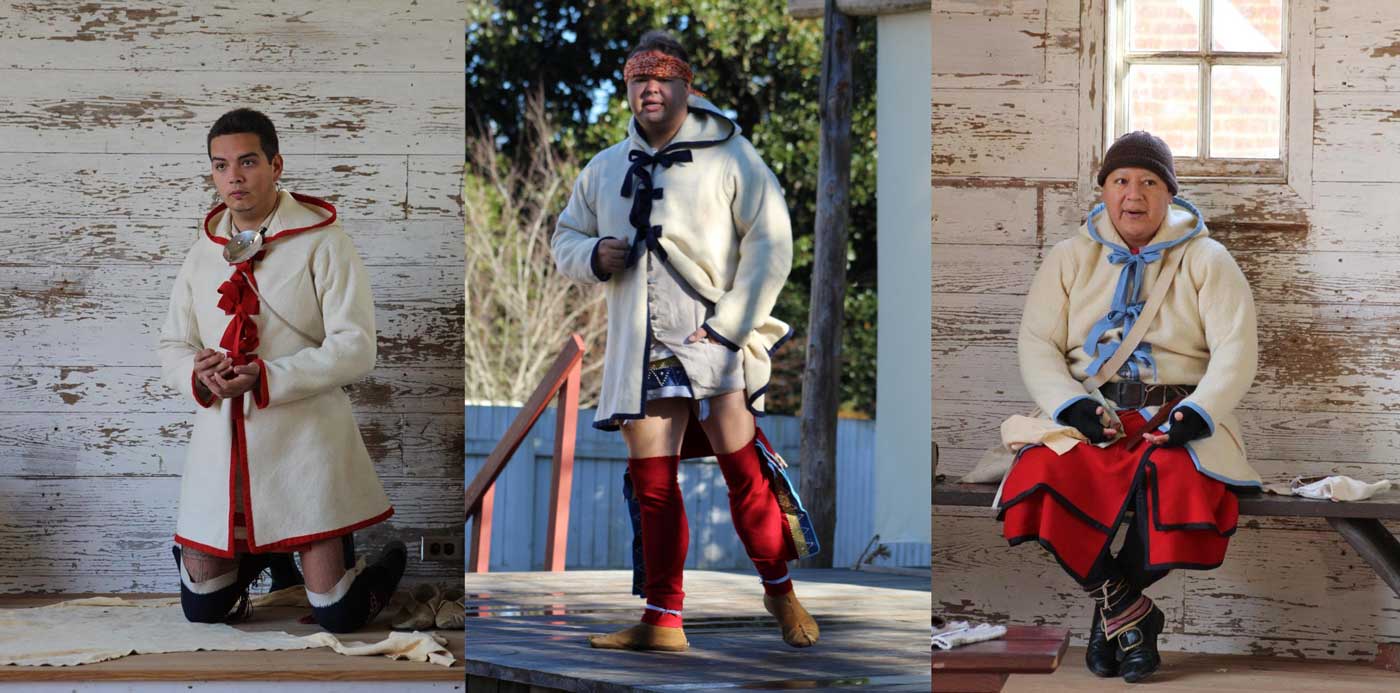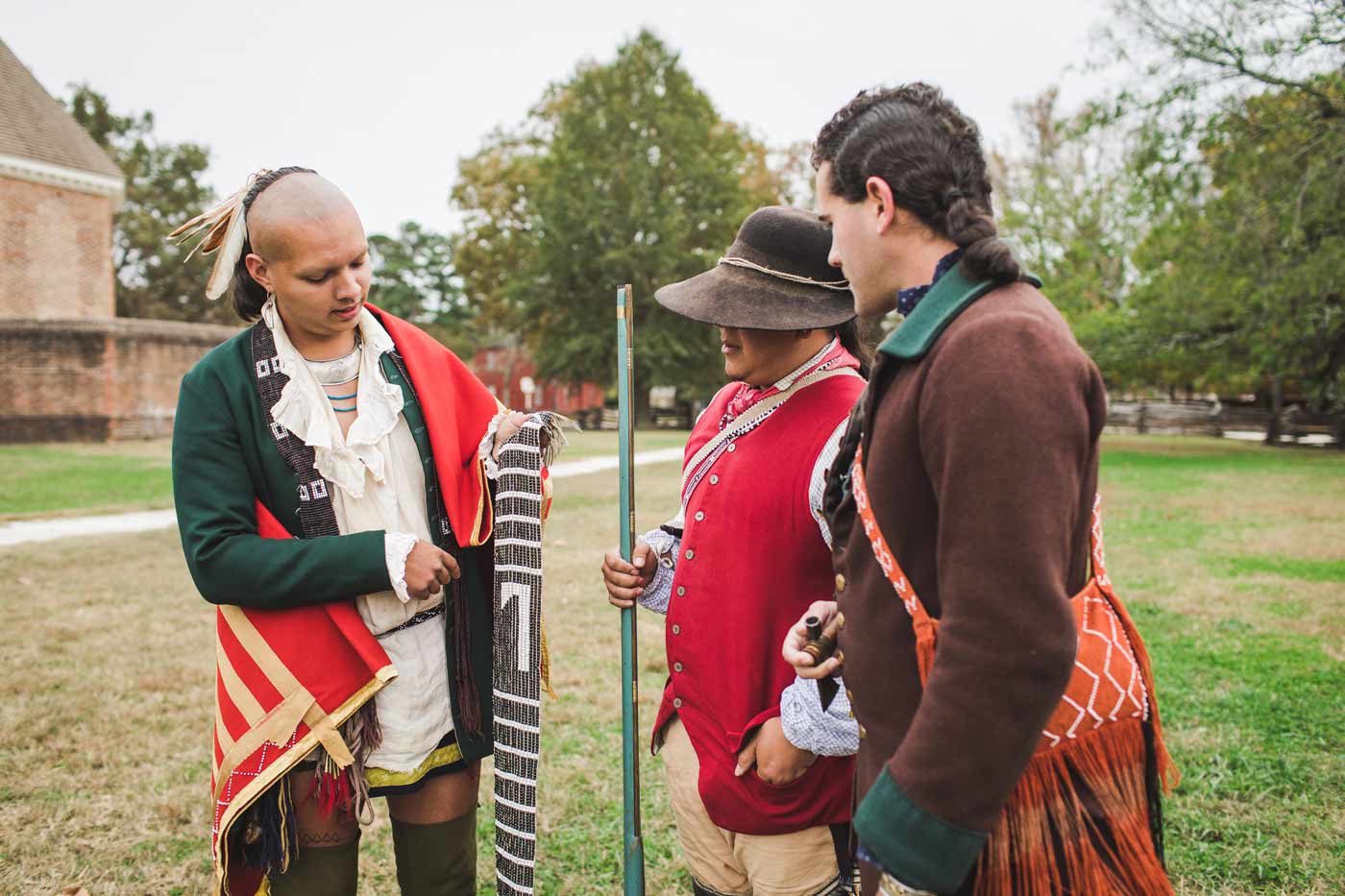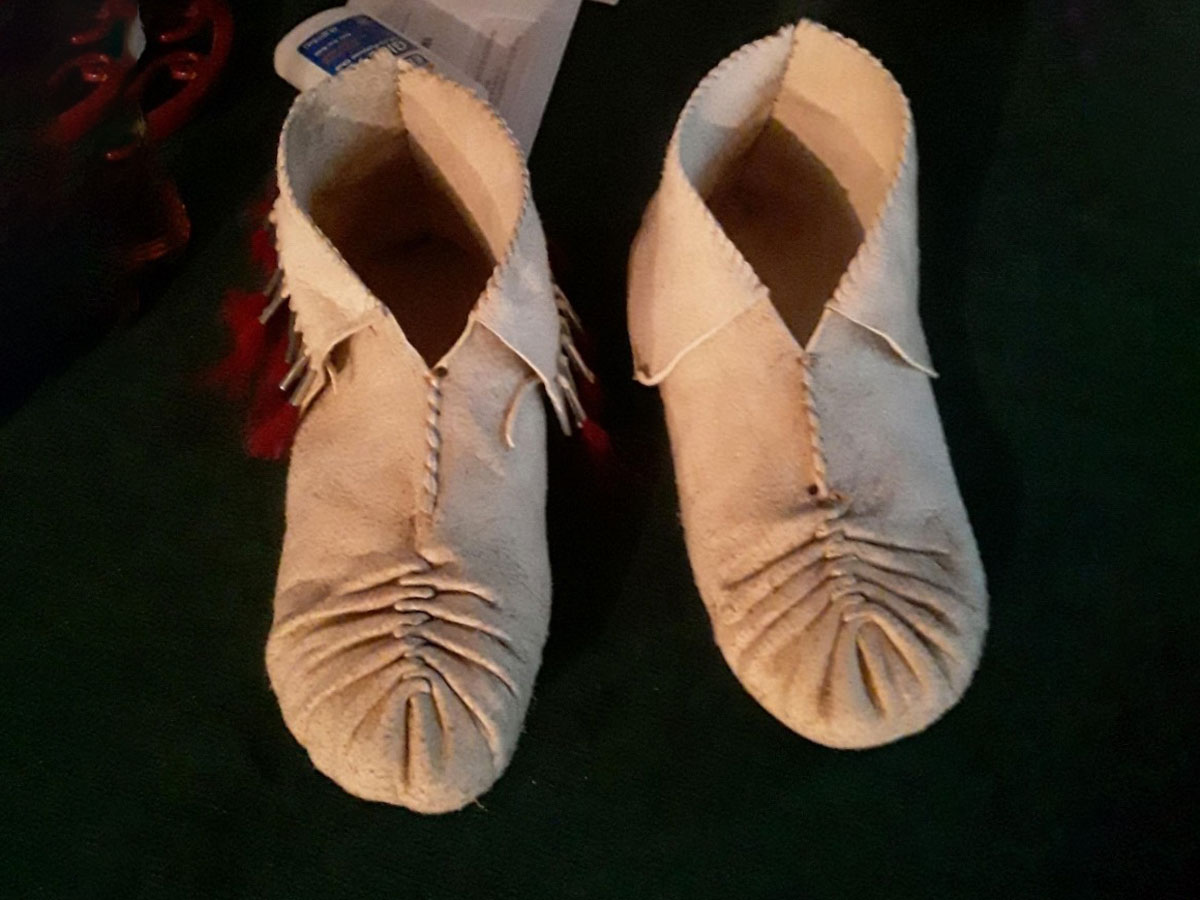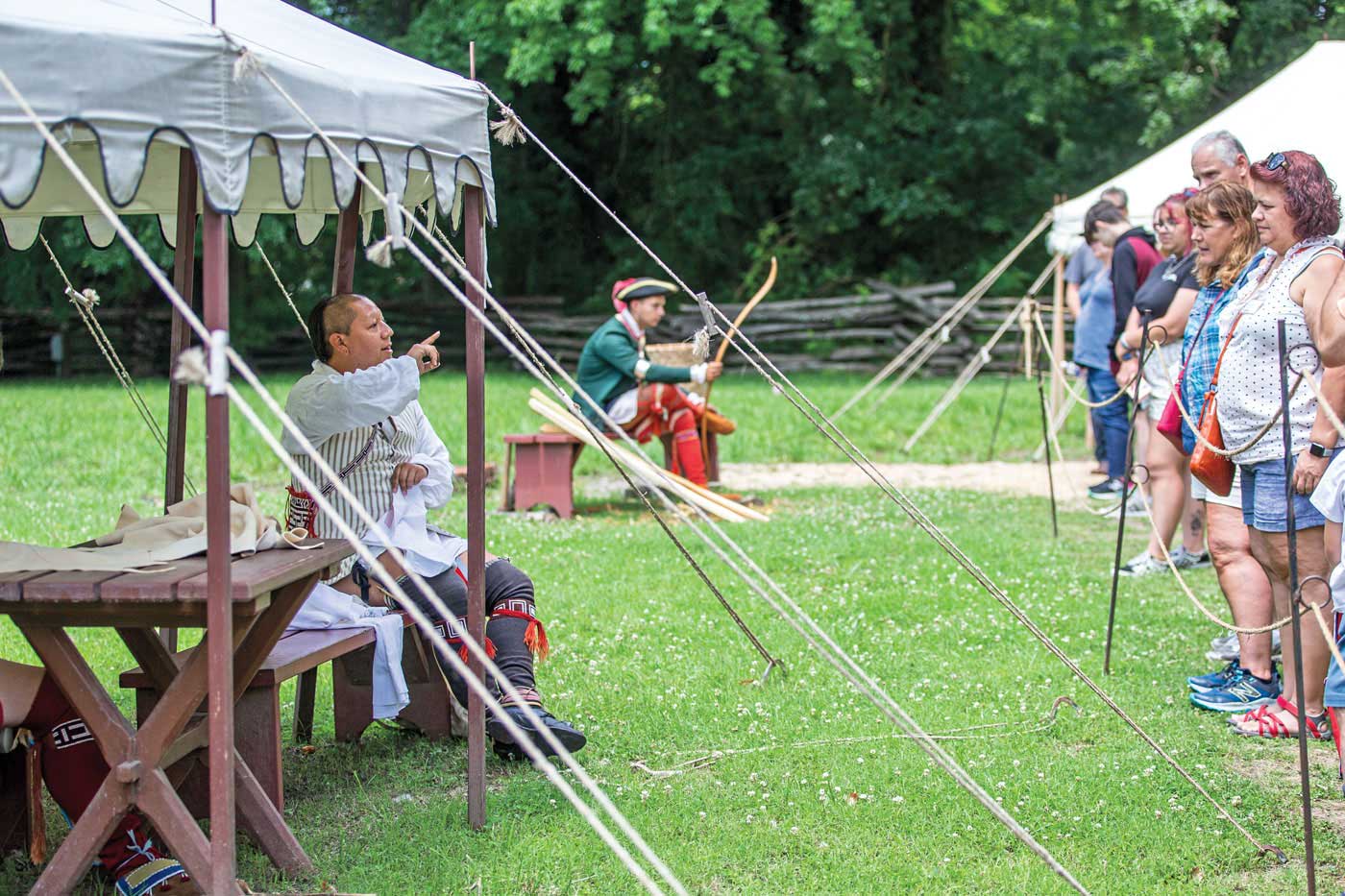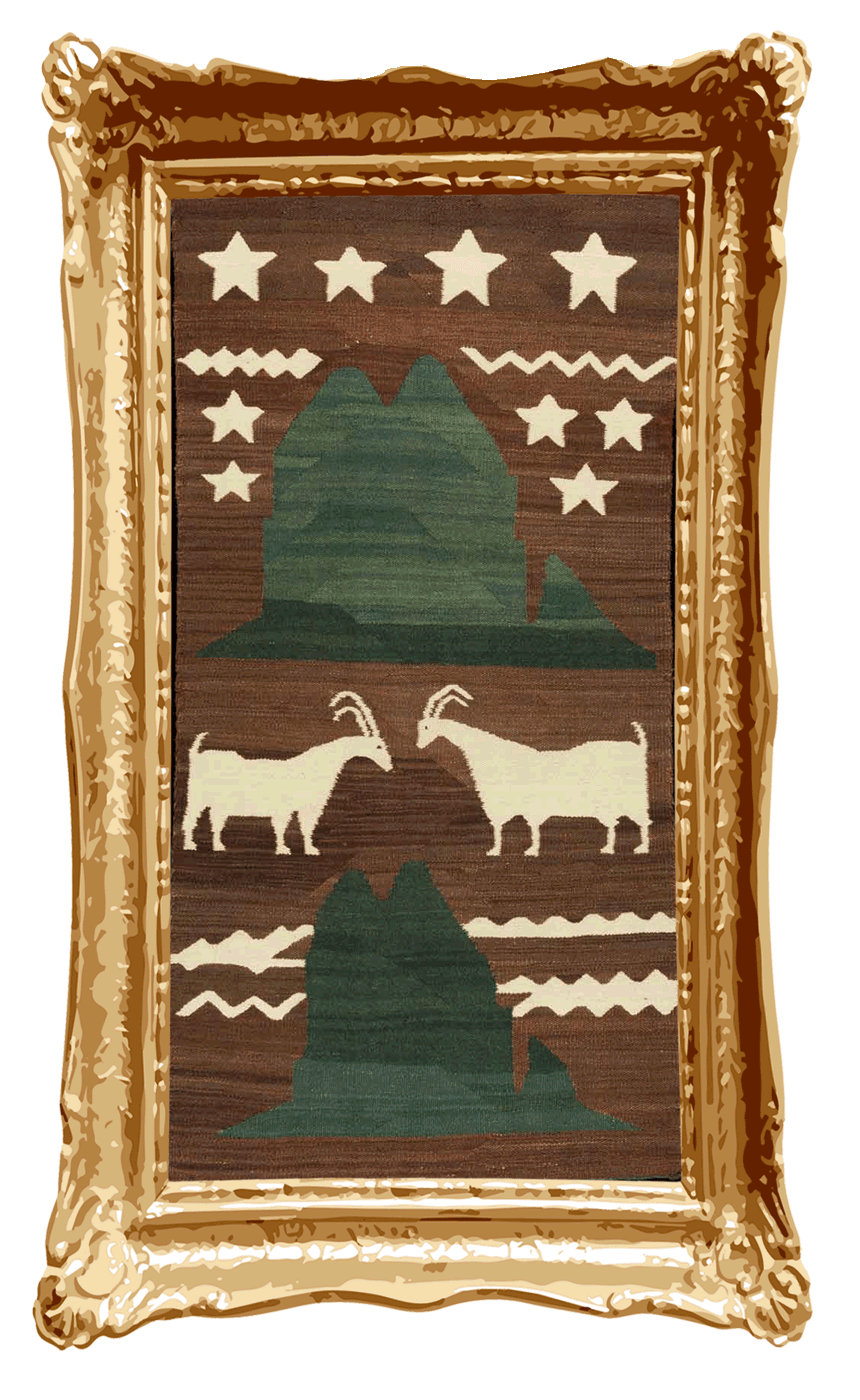Colonial Williamsburg publications & productions
- Aveni, Anthony F.Beginnings and Endings: Of the Maya and the Milky Way, Powhatans and the Giant Hare, Prophecies and Time. Colonial Williamsburg Journal, Autumn 2012.
- Kelly, Kevin P. John Montour: Life of a Cultural Go-Between. The Colonial Williamsburg Interpreter, Vol. 21, No. 4. 2000.
- Swenson, Ben. Pamunkey Recognition. Colonial Williamsburg Journal, Spring 2015.
- Trifone, Nicole. Crossing Paths. Trend & Tradition, Vol. 2: No. 4. 2017.
Electronic Field Trips
Explore our Electronic Field Trips, part of our
Education Resource Library.
Podcasts: "Past and Present"
- Adopted by the Shawnee - Runaway slave Elizabeth found freedom, family, and equality when she was adopted into the Shawnee tribe. After ten years, she returned to slavery. Hope Smith shares the heartbreaking story behind this selfless act. (March 19, 2012)
- Unearthing Indian History - Native American archaeologists reclaim their tribal history in a modern-day dig. Pamunkey tribeswoman Ashley Atkins describes the discoveries. (February 27, 2012)
- A Tribal Relic Returns - A lost relic returns to the Pamunkey tribe in a new form. American Indian Initiative Manager Buck Woodard guides us through treaties and time. (June 13, 2011)
- Where Pocahontas Pledged Her Love - Ongoing excavations at James Fort reveal a surprising discovery: the site of the 1608 church where Pocahontas married John Rolfe. Chief Archaeologist Bill Kelso shares the excitement of rediscovery. (January 24, 2011)
- Williamsburg’s Indian School - The Indian School at William and Mary was conceived for the religious conversion of Indians. Professor Jim Axtell shares the storied building’s history. (November 8, 2010)
- So Far From Scioto - Four Shawnee men visit Williamsburg as diplomatic hostages in 1774. See their story in “So Far From Scioto,” part of Historic Area programming. Buck Woodard shares the details. (April 19, 2010)
- The Cherokee Nation - The modern Cherokee Nation is enjoying a renaissance in language and culture. Living History Demonstrator Paula Nelson shares the resurgence. (November 16, 2009)
- The Native Tongue - Native tribes and colonizers began a dialogue without a word in common. Buck Woodard describes the early exchanges. (January 19, 2009)
- The Chiefdom of Powhatan - Stratified social organization, strategic alliance, and lineage leadership were hallmarks of Powhatan’s rule over southeastern tribes. Buck Woodard describes the society that existed before first contact. (January 12, 2009)
Online Primary Sources
- The Library of Congress documents Virginia's Early Relations with Native Americans.
- Among the billions of historical records housed at the National Archives throughout the country, researchers can find information relating to American Indians from as early as 1774 through the mid 1990s.
- The Smithsonian Institution’s National Museum of the American Indian (NMAI) curates one of the world's most expansive collections of Native artifacts, including objects, photographs, archives, and media covering the entire Western Hemisphere, from the Arctic Circle to Tierra del Fuego.
- William & Mary’s American Indian Resource Center seeks to serve the Native community, scholars and students interested in American Indian culture and history, as well as the public at large.
Books and Articles
For a deeper dive, check out our list of suggested books
and articles available at either Colonial Williamsburg’s
John D. Rockefeller, Jr. Library or William & Mary’s Swem Library.
- Axtell, James. The Rise and Fall of the Powhatan Empire: Indians in Seventeenth-century Virginia. Colonial Williamsburg Foundation: Williamsburg, VA. 1995. Rockefeller Library
- Bruchac, Joseph. Our Stories Remember: American Indian History, Culture, and Values Through Storytelling. Fulcrum Publishing: Golden, Colorado. 2003. Rockefeller Library
- Calloway, Collin G. “Introduction.” In The American Revolution in Indian Country: Crisis and Diversity in Native American Communities. Cambridge University Press: Cambridge. 1995. Rockefeller Library
- Calloway, Colin G. The Scratch of a Pen: 1763 and the Transformation of North America. Oxford University Press: New York. 2006. Rockefeller Library:
- Deloria, Vine Jr. Custer Died for Your Sins: An Indian Manifesto. University of Oklahoma Press: Norman. 1988. Swem Library
- Deloria, Vine Jr. Red Earth, White Lies: Native Americans and the Myth of Scientific Fact. Scribner: New York. 1994. Swem Library
- Dennis, Yvonne Wakim. Native American Almanac: More Than 50,000 Years of the Cultures and Histories of Indigenous Peoples. Visible Ink Press. 2016. Rockefeller Library
- Dunbar-Ortiz, Roxanne. An Indigenous Peoples' History of the United States. Beacon Press: Boston. 2014. Swem Library
- Dunbar-Ortiz, Roxanne and Gilio-Whitaker, Dina. “All the Real Indians Died Off:” and 20 Other Myths about Native Americans. Beacon Press: Boston. 2016. Swem Library
- Egloff, Keith and Deborah Woodward. First People: The Early Indians of Virginia. University of Virginia: Charlottesville. 1992. Rockefeller Library
- Gallay, Alan. The Indian Slave Trade: The Rise of the English Empire in the American South 1670-1717. Yale University Press: Binghamton. 2002. Rockefeller Library
- Hanson, James A. Clothing & textiles of the fur trade. Museum of the Fur Trade: Chadron. 2014. Rockefeller Library
- Johnston, Carolyn Ross. Voices of Cherokee Women. John F. Blair, Publisher: Winston-Salem. 2013.Rockefeller Library
- Josephy, Alvin M. 500 Nations: An Illustrated History of North American Indians. Knopf: New York. 1994. Rockefeller Library
- King, Duane H. Emissaries of Peace: The 1762 Cherokee & British Delegations. Museum of the Cherokee Indian: Cherokee. 2006. Rockefeller Library
- Lovell, W. George, Henry F. Dobyns, William M. Denevan, William I. Woods, and Charles C. Mann. "1491: In Search of Native America." Journal of the Southwest 46, no. 3 (2004)
- McCartney, Martha W. The Pamunkey Indians, from Contact Period to the Twentieth Century. Virginia Research Center for Archaeology: Williamsburg. 1981. Rockefeller Library
- Merrel, James H. “Some Thoughts on Colonial Historians and American Indians.” The William and Mary Quarterly, Third Series, Vol. 46, No. 1, pp.94-119. 1989.
- Moretti-Langholtz, Danielle and Buck Woodard. Building the Brafferton: The Founding, Funding, and Legacy of America's Indian School. Muscarelle Museum of Art: Williamsburg. 2019. Rockefeller Library
- Morris, Michael P. The Bringing of Wonder: Trade and the Indians of the Southeast, 1700-1783. Greenwood: Westport. 1999. Rockefeller Library
- Nabakov, Peter. A Forest of Time: American Indian Ways of History. Cambridge University Press: Cambridge. 2002. Rockefeller Library: E98 .F6 N33 2002
- O’Neill II, James F., ed. Their Bearing Is Noble and Proud: A Collection of Narratives Regarding the Appearance of Native Americans from 1740-1815. J.T.G.S. Pub.: Dayton. 1995. Rockefeller Library
- Perdue, Theda. Cherokee Women: Gender and Culture Change, 1700-1835. University of Nebraska Press: Lincoln. 1999. Rockefeller Library
- Richter, Daniel K. Facing East from Indian Country: A Native History of Early America. Harvard University Press: Cambridge. 2001.Rockefeller Library
- Rountree, Helen C. Pocahontas' s People: The Powhatan Indians of Virginia Through Four Centuries. University of Oklahoma Press: Norman. 1990 Rockefeller Library
- Rountree, Helen C. and E. Randolph Turner III. Before and After Jamestown. University Press of Florida: Gainesville. 2002. Rockefeller Library
- Salmón, Enrique. Iwígara: American Indian Ethnobotanical Traditions and Science. Timber Press: Portland. 2020. Rockefeller Library
- Smith, John, and James Horn. Captain John Smith: Writings with Other Narratives of Roanoke, Jamestown, and the First English Settlement of America. Library of America: New York. 2007. Rockefeller Library
- Spivey, Ashley Layne Atkins. Knowing the River, Working the Land, and Digging for Clay: Pamunkey Indian Subsistence Practices and the Market Economy 1800-1900. PhD dissertation, College of William & Mary, 2017.
- Strang, Cameron B. "Michael Cresap and the Promulgation of Settler Land-Claiming Methods in the Backcountry, 1765-1774." The Virginia Magazine of History and Biography 118, no. 2 (2010): 106-35.
- Trigger, Bruce G., ed. Handbook of North American Indians. Volume 15: Northeast. Smithsonian Institution: Washington D.C. 1978. Rockefeller Library
- Treuer, Anton. Everything You Wanted to Know About Indians but Were Afraid to Ask. Borealis Books: St. Paul. 2012. Rockefeller Library
- Waugaman, Sandra F. and Danielle Moretti-Langholtz. We’re Still Here: Contemporary Virginia Indians Tell Their Stories. Palari Publishing: Richmond. 2000. Swem Library
- White, Richard. The Middle Ground: Indians, Empires, and Republics in the Great Lakes Region, 1650-1815. Cambridge University Press: Cambridge. 1991. Rockefeller Library
- Wolf, Eric. Europe and the People without History. University of California Press: Berkley. 1982. Rockefeller Library: D208 .W64 1997
- Woodard, Buck W. The Nottoway of Virginia: A Study of Peoplehood and Political Economy, c. 1775-1875. Ph. D. thesis in Anthropology College of William and Mary 2013.
- Wright, J. Leitch, Jr. Only Land They Knew: The Tragic Story of the American Indian of the Old South. University of Nebraska Press. 1999. Rockefeller Library
Tribal information and links
Tributary tribes - 1720-50s
(Algonquian) Pamunkey or York River Indians,
Gingaskin (Eastern Shore)
(Iroquoian) Tuscarora, Nottoway [Nansemond & Weyanoke],
Meherrin
(Siouan) Saponi, Occaneechi, Totero [Stuckenox]
Key nations - 1720-50s
(Algonquian)Miami [Picts, Piankashaw, Twightwees],
Shawnee, Delaware
(Iroquoian) Six Nations – Seneca, Cayuga, Onondaga, Oneida, Tuscarora, Mohawk;
Mingo; Cherokee
(Muskogean) Chickasaw
(Siouan) Catawba
Tributary tribes - 1750s
(Algonquian)Pamunkey,
Gingaskin
(Iroquoian) Tuscarora, Nottoway,Meherrin
(Siouan) Saponi
Key nations - 1750s
(Algonquian) Miami [Twightwees], Shawnee,
Delaware
(Iroquoian) Six Nations, Mingo, Cherokee
(Siouan) Catawba
Key Groups – Settlement Indians (Tributary) - 1770s
(Algonquian) Pamunkey,
Gingaskin
(Iroquoian) Tuscarora, Nottoway, Meherrin
Key nations - 1770s
(Algonquian) Miami [Twightwees], Kaskaskia, Shawnee,
Delaware
(Iroquoian) Six Nations – particularly the Oneida, Tuscarora, & Mohawk; Mingo;
Cherokee
(Muskogean) Creek, Choctaw
(Siouan) Catawba
(from Indians in eighteenth century Williamsburg training, B. Woodard,
2011)
What is a Federally Recognized tribe?
A federally recognized tribe is an American Indian or Alaska Native tribal entity that is recognized as having a government-to-government relationship with the United States, with the responsibilities, powers, limitations, and obligations attached to that designation, and is eligible for funding and services from the Bureau of Indian Affairs.
Furthermore, federally recognized tribes are recognized as possessing certain inherent rights of self-government (i.e., tribal sovereignty) and are entitled to receive certain federal benefits, services, and protections because of their special relationship with the United States. At present, there are 574 federally recognized American Indian and Alaska Native tribes and villages.
Modern State Recognized Tribes
What is state recognition?
State recognition is the formal declaration of
recognition to an American Indian tribe located in Virginia by the Commonwealth. Nine of the currently
recognized tribes were recognized through the state legislature, by a bill passed through the House of
Delegates and State Senate and signed by the Governor. Two tribes were recognized through a treaty between
Virginia and a tribal amalgamation.
- Mattaponi Nation
- Pamunkey Tribe
- Chickahominy Tribe
- Chickahominy Tribe Eastern Division
- Rappahannock Tribe
- Upper Mattaponi Tribe
- Nansemond Indian Nation
- Monacan Indian Nation
- Cheroenhaka (Nottoway) Tribe
- Nottoway Tribe
- Patawomeck Tribe
Other important modern tribal links:
- Cayuga Nation
- Cherokee Nation
- The United Keetoowah Band of Cherokee Indians in Oklahoma
- Eastern Band of Cherokee Indians
- Catawba Nation
- Chickasaw Nation
- Delaware Nation
- Mingo - Seneca Cayuga Tribe of Oklahoma
- Occaneechi Band of the Saponi
- Oneida Nation
- Onondaga Nation
- Piankashaw - Peoria Tribe of Oklahoma
- Shawnee Tribe
- The Absentee Shawnee Tribe of Oklahoma
- Seneca Nation
- Tuscarora Nation
- Weyanoke Association
Curated lists for further reading
- William & Mary’s American Indian Resource Center provides a helpful list of Virginia Indian Research References.
- The National Park Service-Historic Jamestowne has compiled a Powhatan Indian Bibliography.
- The Library of Congress, the National Endowment for the Humanities, National Gallery of Art, National Park Service, Smithsonian Institution, United States Holocaust Memorial Museum and U.S. National Archives and Records Administration have compiled a Native American Heritage Month Resources web portal that features selected exhibits and collections.
- The Library of Virginia: Resources on Virginia Indians at the Library of Virginia.
